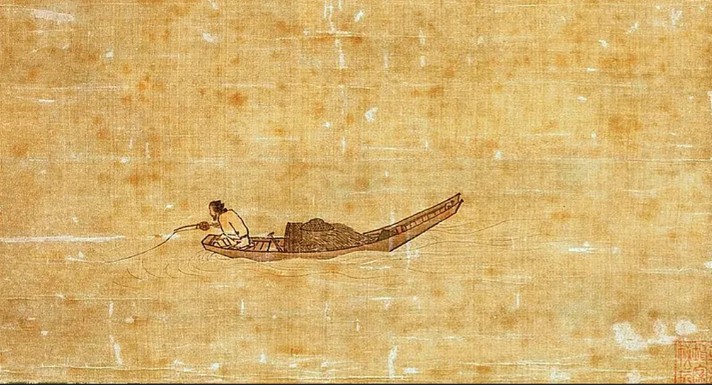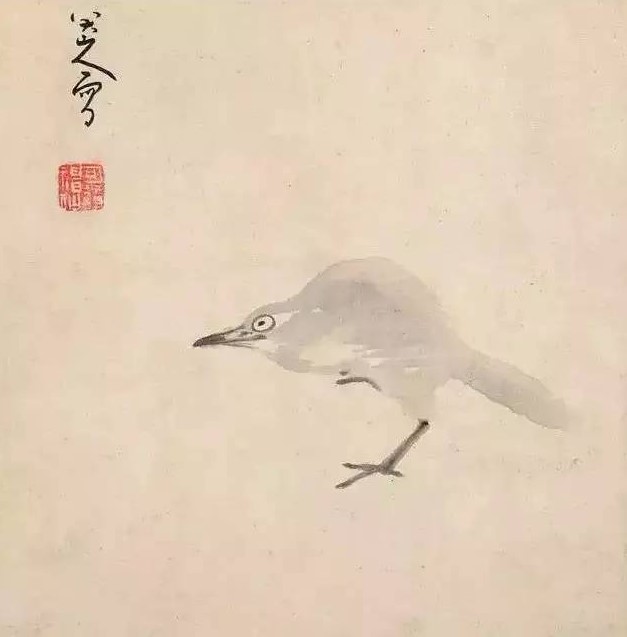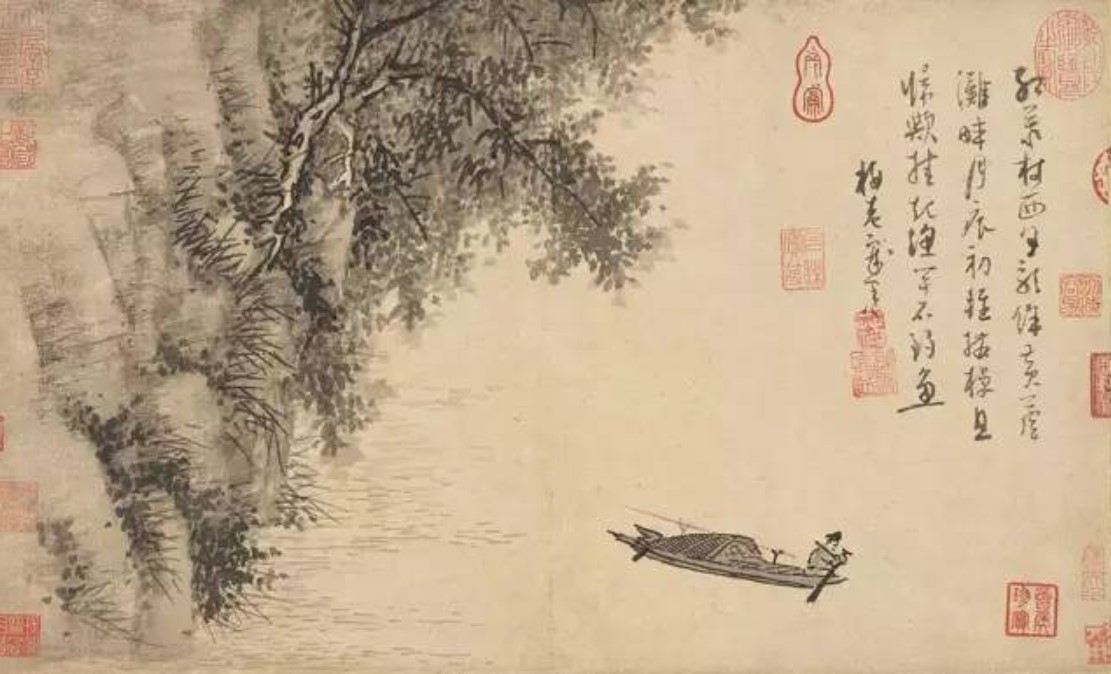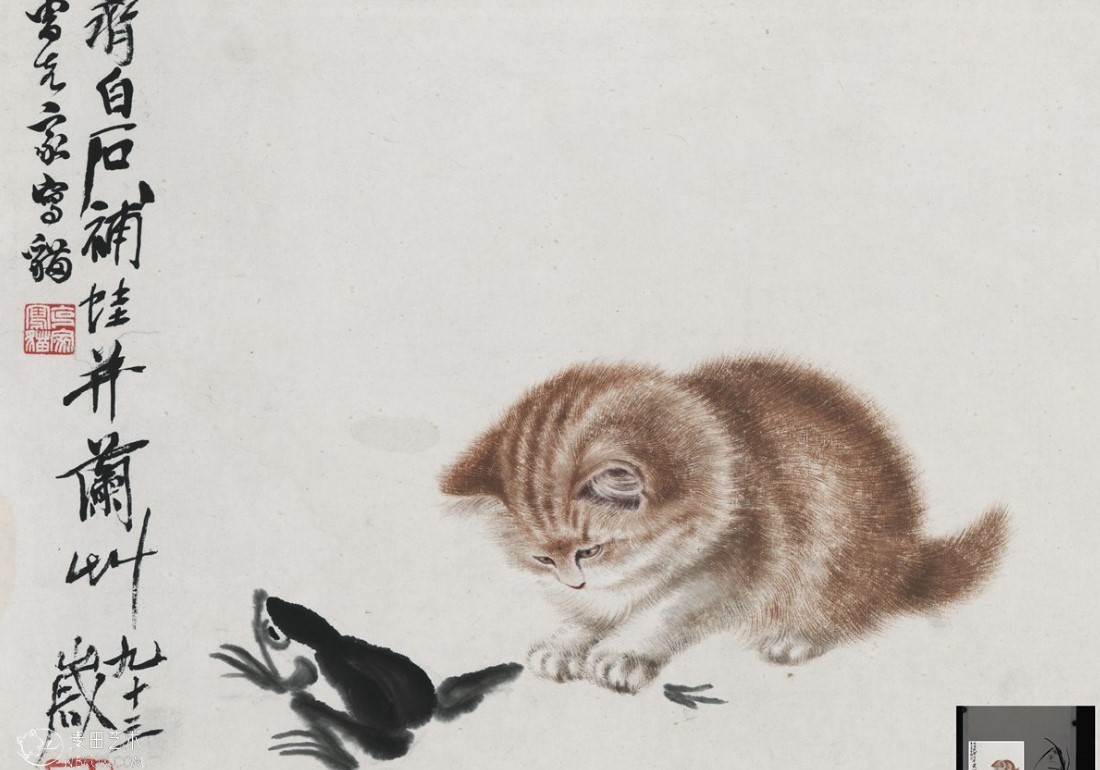很久之前就喜欢“留白”这两个字,这个词无论是在国画,音乐,处事待人,语言艺术上,都深刻地影响着我。最近看了“繁花”这部电视剧,更感触到“留白”两个字的神韵。
王家卫导演在谈他心中“繁花”这部作品的时候说过:
文字有文字的优势,影像有影像的长处。从文字到影像,“不响”是创作密码,是留白而非沉默。不响不代表沉默,它是一种留白。凡事我不想讲的,不能讲的,讲了为难自己为难别人,不响。这也是一个创造者的态度,我只讲我能讲的,我想讲的,我讲得好的。
所以有了“留白”“不响”,人生中的很多情感,才会意犹未尽。借着留白的意蕴,我给大家分享三篇文章(英中法),有相关性,但不是直译。让大家感受国画里,人生里,古人里“留白”的美丽。
-日日吃傻傻笑
The Art of Leaving Blank

by Carina Zhang
Angler on a Wintry Lake is one of the most famous paintings by Ma Yuan, an ancient Chinese artist. Ma Yuan employs slender and modulated lines with a suggestion of tensile strength to depict an angler who is fishing alone on a wintery lake.Ma Yuan is miserly about the use of ink. In his painting, less than one-tenth of the fragile and yellow-tinged fragile piece of Chinese art paper has content, which is merely a brief sketch of the angler and his boat. The rest of the paper is left blank. It is said that this painting is inspired by the poem, “江雪,” which translates to “River Snow,” whose lines state, “In a lone boat, an old man, in rain hat and straw raincoat/Fishing alone, in the cold river snow.”
With that being said, people believe that the poem and artwork connect in the sense that the blank space is used to emphasize his loneliness. In a cold winter, a miserable angler with a small boat was the only life on this earth. More so, Ma Yuan does not even bother to show the audience the angler’s face; but rather, it is his hat that is at the golden section of this painting, which grabs more attention than this angler does. It is hard to not feel sympathetic about to faceless fisherman, whose existence does not seem to make a huge difference to this world.However, the curve of the angler’s fishing line interests me. His fishing line concaves up, which violates the law of gravity, unless an external force was exerted makes it into this unnatural shape. Where is this force from?It is this minute vibration of his fishing line that brings motion to this painting.
The angler stretches out his neck to have closer look at this vibration, and his sudden motion disturbs the inertia of the boat, making it lean toward his side. The ripples from his boat resonate with the vibration of his fishing line. At this moment he is no longer alone. The life of the curious creature that gets tempted by food and bites his hook magically intersects with the life of the angler, on a depressing and snowless winter. The world is in dead silence, but the weak vibration brings a sound. Now, the angler is not alone.Aside from the waves from his boat, the surface of the water is perfectly still. Because ancient Chinese painters believe in Daoism- which values attaining the limit of empty space while also retaining extreme stillness — Ma Yuan chooses to use this practice by leaving blank space to depict stillness.
However, the vibration makes me wonder about the limitless possibilities that are hidden under the surface of the lake. It is generally known that in Chinese paintings, the blank space is called “the white,” while the ink is called “the black.” I am absorbed by the white, wondering what it represents. It could be the lake, the sky, the mist, the cloud, or the state of mind. On a paper of unimpressive size, without brilliant colors, complex layers, or thick textures, the blank, or the white, frames all possibilities. I imagine the angler on a tiny boat floating on a boundless lake, as the cold wind of winter dye both the lake and the sky white. He must feel small in front of nature, on a boundless lake covered by white mist.
However, under the seemingly quiet surface of the lake, life is flowing. The blank is not empty, but full and infinite. The absence of brushes and ink leaves space for chance to come in. The blank space entices me in, lets out human beings’ monstrous imagination. In the natural world, the color white is the combination of various colors; in this painting, the concept of “white” is analogously inclusive, embracing every kind of interpretation.
When an artist gratuitously gives the audience abundant details, the audience could find it hard to pay attention to all of them at once. However, when the details are condensed in one corner of a piece of artwork, the audience will treasure every stroke of ink on the paper. I wonder why the angler is not even wearing his straw hat and cloak on a freezing winter day? He is small compared to nature, but he must feel secure, and thus he does not need to protect himself from nature. One could say that he might even love the winter. Though he is in solitude, does it mean he is depressed or lonely or unhappy? Looking closely, I find that the curvature of the angler’s back resembles that of the waves on the lake. Doesn’t it imply that the lake actually reflects his mind? While the blankness transcends the space, and the stillness transcends the time, the angler’s mind goes beyond the mundane interpretation of human emotions. At this moment, humanity and nature finally unite.
I leave the angler after I feel the resonance in the motion of this painting because my presence will disturb his transcendence in solitude. He is part of the blank. The angler is neither alone nor lonely. He is free from restraints, and he uses the void around him to get me absorbed, lost, and found myself again. He is neither alone nor lonely. Art is born in these impossible intersection points of contradictory concepts, where motion and stillness, blank and fullness, solitude and resonance, all come together.

人生,需要留白;不尽,方是完满
摘自京博国学
即便是不懂画的人,也能一眼看得出中国画和西洋画的不同之处:西洋画,满;中国画,空。一张画纸,画得满满当当不留一点空白,是西洋油彩画;一张画纸,寥寥数笔丹青于白宣之上,是中国画。中国画的最高境界,在于水墨留白。中国话的最高境界,在于话音留三分。
有些话,想说五句,其实只需两句对方便明白意思。剩下的三句,跟主题不再有过多关系,只是满足你的倾诉欲,听多了,对方反而会腻。越是话多之人,往往挚友不多。一则话多总易误伤旁人,二则心讲得太明白,别人会减少了与你交心的兴趣。
真正有分量的人,只会讲有分量的话。一个敢于少讲话的人,必定是对自己话中传达的威力有信心的人。衣若素雅,能凸显你的脸庞。妆若素淡,能映出你的气质。着墨少一点,否则它会抢了要害之处的风头。人生需要留白。那些人生的留白,让你看起来更为丰富。一个会布局的人,永远不会把人生塞得太满。留白,方能走得长远
留白,又称“余玉”,原是中国画中一个重要的艺术表现手法。大致可理解为预留空白,但留白不空,留白不白,不能将它全等同于空白。所谓“无画处皆成妙境” “行得之于形外”。
太极八卦中的黑白鱼样图式,解读着世间万物生发变化、循环往复、无穷无尽。国画中的黑为墨,白为纸,二者为色之极端,墨可分五色,白有无尽意。正如宗白华所言:“中国画最重空白处。空白处并非真空,乃灵气往来生命流动之处。且空而后能简,简而练,则理趣横溢,而脱略形迹。然此境不易到也,必画家人格高尚,秉性坚贞,不以世俗利害营于胸中,不以时代好尚惑其心志:乃能沉潜深入万物核心,得其理趣,胸怀洒落,庄子所谓能与天地精神往来者,乃能随手拈来都成妙谛。”画面上适当的留白,使画面不阻塞、不凝滞,仿佛天地间之灵气自由往来其中,充溢着画家无尽的空灵的风神气韵,以及广阔无垠的宇宙空间感。同时,产生所谓的“韵外之致”“、境外之情”,使观者生出无尽的遐思妙想。如老子就主张“有无相生”“虚而不屈,动而愈出” ,有无相互映衬,虚实相互结合,才能真正产生“超乎其外,得乎其中”的意境美。缺落之处,知觉使其完形。不确定,不明晰,故而闪烁恍惚。
恰如老子所说:“恍兮惚兮,其中有象。”如果整张纸满满当当,断然没有美感可言。白”即“无”,绘画中的这种语言就是遐想的生境,“无”含“无为”之意,在画面中起到“无为而无不为”的效果。国画水墨渗韵与妙造的留白,让“无中生有”达到了一个智性的高度。人生也是一样,留白,才可以走的更远。我们的生活节奏在变得越来越快,不敢停下脚步。拼搏固然无错,但节奏掌握不好,往往得不偿失。周边不乏年纪不大,被查出不治之症的人,只能哀叹。其实,结局早已写好,年轻时拿命换钱的人,往往年老时拿钱换命,还不见得能换回来。想想看,你那么拼命的挣钱是为了什么?白手起家,憋着一口气,想做一番事,挣到20万,想要50万,挣到50万,想要一百万……经常出差几个星期才回家一次,经常在家人睡梦中抵达,错过孩子一个个成长瞬间。对的,创业不吃点苦受点累哪那么容易做大?可创业的目的不是为了吃苦受累,而是完成原始积累以后的丰收。满满的拼搏奋斗,把温情置于何地呢?
这一辈子说长不长,说短不短,有人说,我重质,不重量,没有质量,一辈子再长,又有什么意义? 苟且的活着,猥琐的活着,也毫无意义。但什么是生命的质量?我们一出生就是一场必然要奔向死亡的旅行,急匆匆赶路的同时,不抬头看看路旁的风景么?不抬眼看看与你牵手同行的旅伴么?正因为什么都带不走,所有你看到的、体验到的,都是赚到的。正因为时间不可逆转,所以更不可以悲观,要专注于每一个当下。不如放慢脚步,给自己留一片“空白”从前的日光很慢车,马,邮件都慢一个问候,要等上好多天从前的月光很慢有点闲,有点懒在一杯茶里消磨整个黄昏在半个梦里看星星满天从前的脚步好慢从一个村子,到另一个村子要走一天的时间从前的日子很慢,很暖。裹在淡淡的烟火里,日日年年。
从前的手帕也好看最是那低眉的女子精致的,一针一线从前的爱情很慢慢的,用一辈子去等一个人慢的,一生只够爱一个人现在的日子很快,如同按了快进键,不知不觉又是一天,没错,你拼搏的姿态很美,但别忘了回家卸下防备。控制住走着走着就快了的脚步,你才不是只耽于行路本身。激流勇进的刺激过后,是渐缓的水中荡漾。什么都不做,不要有负罪感,首先得意识到,给自己留一片“空白”之于生命有多么重要。满则溢,盈则堵。人生,需要留白留白的说法最早来自于国画,画如果过满过实,在构图上就失去了灵动与飘逸,显得死气沉沉。这时候就如果留下适当的空白,便有了无尽的绮思遐想。就好像南宋马远的那副《寒江独钓图》,画中只有一人一舟,却让人有烟波浩渺之感。 这不就是所谓的“此处无物胜有物”吗?书法中也常常讲究留白,在虚实之间穿插,不能满,满了则乱。也不可太小,否则太过于空旷,留白是一种格局与智慧,其中尽显美得韵味。在京剧表演艺术中,也常有用到留白的艺术,所谓三两步走遍天下、六七人百万雄兵即使如此。又像古人的作诗之法,不着一字,尽得风流。我们生活的很多方面都需要留白。
留白是一种处事的智慧,是一种淡定的对待生活的态度,是一种生活的方式。古人说,凡事留不尽之意则机圆,凡物留不尽之意则用裕,凡情留不尽之意则味深,凡言留不尽之意则致远,凡兴留不尽之意则趣多,凡才留不尽之意则神满。人生一世,如白驹过隙。人生的任务一个接一个,好像永远停不了。重重压力与责任之下的我们总在忙于奔跑。疲惫的心灵需要一段留白,给心灵放假,保持一颗清净之心,与纷扰红尘里淡定的做你自己。才能游刃有余、退去浮躁,这也正是“一张一弛,文武之道”的道理。人与人的相处也需要留白,无论是友情、亲情还是爱情。每个人都可以并且应该拥有自己的秘密。
再亲密的关系,也必须给别人留下空间,不要试图走入对方的太过私密的领地。适当的留白,是对彼此的信任,拥有留白的关系才会轻松和惬意。留白亦如同一点欠缺与遗憾,生活中的不足,白玉中的瑕疵,就好像过于完美的形象或情感都存在于书中画里——正因其难得,所以愈加美好。林语堂曾说“看到秋天的云彩,原来生命别太拥挤,得空点。” 川端康成曾经叹息:“这世界太拥塞了。”人生应该如这样一副卷轴,应当有浓墨重彩,却也应当有所留白——既有一步步的坚定,又有些许回味与遐想。这样大概才是完满。

La représentation du monde dans la peinture chinoise
par Corentin Viault
S’intéresser à la notion de monde, c’est notamment s’intéresser à la manière dont les Hommes l’ont compris, la manière dont ils l’ont expliqué. Ces compréhensions du monde se retrouvent notamment dans les arts picturaux, étant l’incarnation de la manière dont les Hommes se représentent le monde. Dans cet article, nous allons essayer de comprendre dans quelle mesure la peinture chinoise est un reflet de la représentation du monde des Chinois , notamment sous le prisme de la notion de vide, et dans quelle mesure la peinture a une fonction éminente dans le rapport entre ces derniers et le monde. Nous procéderons ainsi notamment à une lecture de l’essai Vide et plein, le langage pictural chinois, de François Cheng, que nous vous invitons à lire pour comprendre au mieux le propos riche et complexe de son auteur.
La compréhension du monde dans la philosophie chinoise
La compréhension du monde dans la pensée chinoise est régie par une philosophie fondamentale qui propose des conceptions précises de la cosmologie, de la destinée humaine et du rapport entre l’homme et l’univers. Cette philosophie est notamment centrée autour de la notion de vide, qui est à la fois l’état suprême de l’origine du monde et l’élément central dans le rouage du monde des choses : il est donc à la fois originaire et fonctionnel. Le vide est conçu comme une substance, il se saisit à l’intérieur de toutes choses, il est au coeur même de la substance des choses du monde et de leur mutation.
Pour comprendre cela, on peut par exemple parler de l’image de la vallée, qui est sa représentation concrète dans l’ordre du réel : celle-ci est creuse, pourtant elle fait pousser et nourrit toutes choses : elle les contient toutes et sans jamais se laisser déborder et tarir.
Cette notion de vide a aussi une grande importance dans le lien entre l’homme et le monde. En effet, selon la pensée chinois, et surtout celle des taoïstes, ce qui garantit d’abord la communion entre l’homme et l’univers, c’est que l’homme est un être non seulement de chair et de sang mais aussi de souffles et d’esprits ; il possède le vide en lui.
Ainsi, par le vide, le coeur de l’homme peut devenir la règle ou le miroir de soi-même et du monde, car possédant le vide et s’identifiant au vide originel, l’homme se trouve à la source des images et des formes. Il saisit le rythme de l’espace et du temps, il maîtrise la loi de la transformation. Le vide est donc en quelque sorte un but à atteindre dans la vie, pour la compréhension du monde.
La peinture, une place éminente dans le rapport au monde
A partir de cette philosophie, la peinture occupe une place très importante. En effet, selon les chinois, elle révèle le mystère de l’univers. La peinture, “ par l’Espace originel qu’elle incarne, par les souffles vitaux qu’elles suscite, semble plus apte encore, non pas tant à décrire les spectacles de la création mais à prendre part aux gestes mêmes de la création “ , elle vise à la reproduction de la création du monde même, qui lui confère ainsi toute une dimension sacrée.
Elle constitue ainsi une mise en pratique de la philosophie du monde des Chinois, et donc a un grand lien avec la vie, en ce qu’elle permet d’approcher le vide : elle vise à recréer un espace où la vie est possible, du fait de la présence du vide.
La peinture, la représentation picturale du rapport de l’Homme au monde
Pour recréer le monde dans la peinture, l’artiste va ainsi développer des techniques au niveau des pinceaux comme de l’encre, pour faire transparaître le vide dans le monde. Cette représentation du vide commence notamment par l’usage du pinceau, qui vise, par le trait qu’il trace, à capter le “ li (ligne interne) “ des choses, ainsi que les souffles qui les animent, et donc ne se réduit pas à une simple réduction des formes de la nature.
Le trait est à la fois forme et teinte, volume et rythme, impliquant la densité fondée sur l’économie de moyens et la totalité qui englobe les pulsions mêmes de l’homme. Par son unité, il résout le conflit que ressent tout peintre entre le dessin et la couleur, la représentation du volume et celle du mouvement.
De plus, les artistes ont notamment privilégié pendant une période l’encre sur la couleur, car elle peut exprimer les infinies nuances de la nature, et d’autre part, se combinant avec l’art du trait, elle offre une unicité qui résout la contradiction entre dessin et couleur, entre représentation du volume et rythme du souffle.
La peinture ne vise pas seulement à la représentation du monde extérieur : il s’agit pour l’artiste de projeter son monde intérieur, notamment au travers des éléments de la nature qui prennent une signification.
C’est dans ce sens que Shih-t’ao, un peintre chinois, en parlant du trait unique, dit qu’il est le trait d’union entre l’esprit de l’homme et l’univers ; le trait, tout en révélant les pulsions irrésistibles de l’homme, reste fidèle au Réel. C’est aussi dans ce sens qu’il faut entendre le célèbre adage de Chang Tsao des T’ang « au dehors, prendre le modèle sur la création ; à l’intérieur, suivre la source de l’âme »
Conclusion
Ainsi, le papier vierge est considéré comme le Vide originel par où tout commence, le premier trait comme l’acte de séparer le ciel de la terre, les traits qui suivent et engendrent eux les multiples métamorphoses du premier trait, et enfin, l’achèvement du tableau est le degré suprême d’un développement par lequel les choses retourne au Vide originel. L’acte de peindre est ainsi dans la philosophie chinoise l’acte d’imiter, non pas les spectacles de la création, mais les gestes mêmes du créateur du monde.

